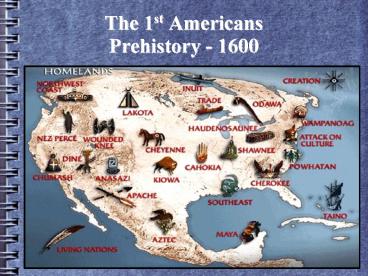The 1st Americans Prehistory - 1600 - PowerPoint PPT Presentation
1 / 35
Title: The 1st Americans Prehistory - 1600
1
The 1st AmericansPrehistory - 1600
2
So, how did they get here?
- Most likely on a landbridge, or area where two
continents were connected together - Two Major Landbridge Theories
- Trans-Atlantic Landbridge
- Bering Strait Landbridge
3
Trans-Atlantic Landbridge
4
Bering Strait Landbridge
- More commonly accepted theory
- Only 18 miles apart from Russia Alaska
- Rough climate, many rough storms (any Deadliest
Catch fans?) - Most likely terrestrial, not oceanic, route
5
Bering Strait Landbridge
- Most water trapped in glaciers
- Less water more land
- The landbridge, known as Beringia, was an ideal
climate for vegetation, hunting, herding - Some stayed in Alaska most migrated South
6
(No Transcript)
7
Migration Theories
- Bird patterns
- Sailed Pacific coastline
- Followed herds east, then south via waterways
8
Life Flourishes in the 'New' World
- Animals in completely 'natural' habitat
- Abundance of animals hunting flourishes
- More food More babies
- Population increases
9
The Bridge is Closed
- After 10,000 years, landbridge covered by water
due to climate change - Americas isolated for 11,000 years
- Next confirmed contact Vikings c. 900
Land Bridge Changes - 20,000 BC to Present
10
Pre-Columbian Contact?
- Some scholars theorize that there was constant
contact with Natives - Cultural diffusion
- Similar religions, agriculture, forms of
government - Examples Republicanism Greeks,
Romans Confederacy Iroquois, Mayans, Aztec
11
Sweet Potato!
- Sweet potatoes, native to the Americas, begin to
be cultivated in Polynesia c.700 - How did they get there?
- Polynesian Trade Triangle
12
(No Transcript)
13
More in common
- Sweet potatoes first appear in Polynesia around
700 - 1000 AD - Unlikely that the plant could successfully travel
across ocean by natural means - Chickens also introduced to S. America circa
1300 - 1400 AD, about 100 years before
firstEuropeans first arrive - Chickens closely resemble Asian species in
American Somoa, unlike European chickens - For any account, it's not until post-Columbus
that Europeans and others begin to settle in
Americas
14
So, who are these Native Americans?
- What do they call themselves? -Indians?
-Natives? -1st Americans? - Most simply refer to themselves as the name of
their tribe -Passamaquoddy - Cherokee
Mohawk - Inuit (in-yoo-it) - the people
- Heterogenuos
- Roughly 100 million natives before arrivalof
Euros.
15
(No Transcript)
16
Diversity??
- Extremely diverse, both in culture
environment -Newfoundland, Mexico, Brazil,
Maine, Alaska, New Jersey, Colorado, Florida - Various forms of govt.- Theocracy, Oligarchy,
Republic, Confederacy
17
Diversity??
- Advanced in science, math, astrology, and
medicine -over 40 of modern pharmaceutical
ingredients used in America before 1492!! - Why is this diversity so important?
- Because America was so large diverse, it
threatened every medieval teaching assumption
about human nature, origin, and destiny - Shockwaves sent through European ethnocentrism
18
European Contact A Clash of Cultures
- Europeans (Columbus) arrive on Hispaniola in 1492
- 3 month journey at sea tired, delusional, smelly
- This island does NOT remind them of the India
from Marco Polo's stories
19
Impressions of Each Other
- Europeans?
- Native Arawaks?
- Can not speak each other's language
20
A Picture is worth a 1,000 Words
21
Montezuma
22
Quick Write
- What does this quote mean to you? What does it
say about the different values of the Europeans
and the Native Americans? - Montezuma, Aztec Ruler - What do you do with
gold? Do you eat it? - Cortes, Spanish Explorer - No, we have an
illness only gold can cure.
23
North American Tribes
- No standing army
- Small groups
- No official boundaries for property, territory
- Most did not engage in conquest
- Placed freedom of community above the freedom of
the individual
24
Difference in Property Ownership
- Communal property
- Land was a necessity for survival, and thus could
not be owned by an individual, only a tribe - Leased land
25
European Views of Property
- Life, Liberty, and Property
- Private property part of European culture
- The end of Feudalism marked beginning of private
property
26
KING
NOBLES
LORDS
Peasants / Commoners
27
Feudal Contract
LORDS
GIVE SERVICE TO
GIVE PROTECTION TO
Common Folk
28
Ask the Class....
- Native Americans and Europeans had vastly
different views, beliefs, and practices when it
came to property use and ownership. - What problems/conflictsmight happen because
oftheir different beliefs in property ownership?
29
Mercantilism
- Europeans believe in mercantilism, this is their
main reason for wanting to acquire property - Mercantilism More land More More power
30
Make Me a Map
- In order to claim property, Europeans first
needed to explore and map their discoveries
31
Land Conflicts
- Native Americans already inhabit areas being
claimed - Europeans claim they have no rights to property
(no maps, contracts, treaties, etc.) -No proof
of ownership - Natives sign contracts, thinking they are
allowing Europeans to use their land, when they
actually are selling it to the Europeans
32
Key Events in Early Exploration
- Conquistadors (c. 1500)
- Protestant Reformation (1517)
- Spanish Armada (1588)
- Pueblo Revolt (1680)
33
(No Transcript)
34
(No Transcript)
35
(No Transcript)































